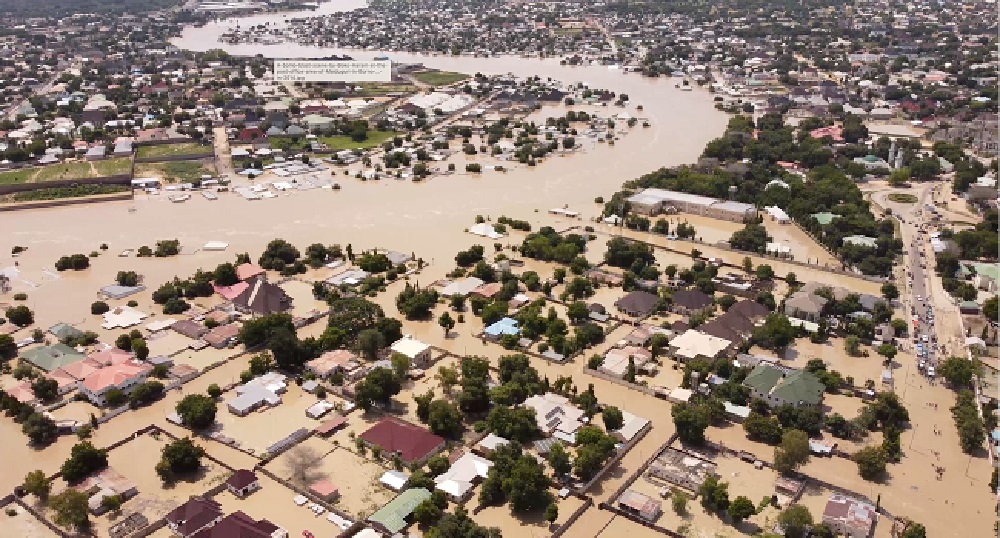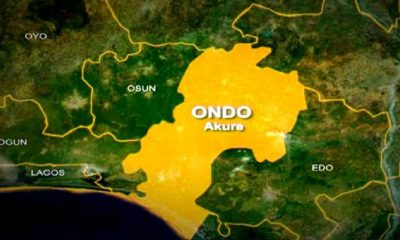News
What You Should Know About Maiduguri Flood

Maiduguri, the Borno State capital, was hit by severe floods with the collapse of the Alau Dam Tuesday morning after torrential rainfalls in the region.
Below is a list of what we know about the flood
Alau Dam
The Alau Dam which is located in the Jere Local Government Area, some 20km away from the metropolis, broke out on Tuesday morning causing flooding along the riverine areas including major roads, zoos, schools, hospitals and other public facilities.
Borno State Governor, Babagana Zulum, blamed the flood on the overflow of Alau Dam which was caused by the release of water from other dams in Cameroon.
The National Emergency Management Agency (NEMA) has described the flood as unprecedented.
“It is an unprecedented incident,” NEMA spokesman Ezekiel Manzo told AFP on Tuesday. “Some of the central parts of the city that have not witnessed flood in so many years are witnessing it today.”
History Repeating Itself?
30 years ago, Maiduguri experienced a flood which the people of Borno tagged “Ambaliya”. The flood ravaged a lot of communities and businesses. And 30 years after, another flood rocked the state as a result of explosion from the Alau dam.
But this time around, the United Nations Human Rights Refugee Council (UNHCR) and residents of the Maiduguri Metropolitan Council (MMC) described the flood as the city’s worst experience when compared to the flood that swept the city in 1994.
“NE Nigeria’s humanitarian hub, Maiduguri, faces its worst flood in 30 years after the Alau Dam overflowed. Homes are submerged, schools shut down & businesses crippled as people evacuate with their belongings,” the refugee council said on its X handle.
Over One Million Displaced
According to the governor, over one million people have been displaced by the devastating floods.
A lot of these people have had to flee their homes to dry lands thus seeking refuge in Internally Displaced Peoples (IDP) Camps located along the western hemisphere of the metropolis.
NEMA and other humanitarian bodies are working tirelessly to rescue those who are still trapped in their homes as well as provide shelter for those who have been evacuated.
80% Animals Dead
The Sanda Kyarimi Zoo Park was also not spared from the floods as some wild animals have escaped from captivity.
According to the General Manager of the Zoo, Ali Abatcha, 80 per cent of the animals in the zoo have been killed by the flood while others have escaped into the city.
Footage circulating on social media shows an ostrich walking one of the streets of Maiduguri. There are reports that snakes and crocodiles have also been seen moving in the flood.
Over 280 Inmates Escape Detention
Over 280 inmates have escaped from the Maiduguri Medium Security Custodial Centre located in the Abaganaran area after severe flooding submerged the prison. The flood breached security barriers and weakened the structure leading to a jailbreak.
Authorities and residents have expressed concern that many of the escapees are highly dangerous thus posing a threat to public safety.
Nevertheless, a statement from the spokesman for the service, Umar Abubakar, disclosed that the federal government is working to evacuate the correctional centre.
News
Court Jails Two Six Months for Naira Abuse in Lagos

The Lagos Zonal Directorate 1 of the Economic and Financial Crimes Commission, EFCC, on Thursday, May 8, 2025, secured the conviction and sentence of the duo of Babatunde Peter Olaitan and Tobilola Olamide to six months imprisonment each for mutilation of the Naira notes.
They were jailed by Justice Alexander Owoeye of the Federal High Court sitting in Ikoyi, Lagos.
The convicts were arraigned on a separate one-count charge of tampering with the Naira notes and spraying, to which they each pleaded “guilty”.
The charge against Olaitan reads: “That you, BABATUNDE PETER OLAITAN, on 8th April 2025, at 23, Macdonald Road, Ikoyi, Lagos, within the jurisdiction of this Honourable Court, whilst dancing during a social event, tampered with funds in the denomination of N200 (Two Hundred Naira) issued by the Central Bank of Nigeria by spraying it, and you thereby committed an offence contrary to and punishable under Section 21(1) of the Central Bank Act, 2007.”
The charge against Olamide reads:”That you, TOBILOLA OLAMIDE A.K.A TobiNation, on 8th April 2025, at 23 Macdonald Road, Ikoyi, Lagos, within the jurisdiction of this Honourable Court, whilst dancing during a social event, tampered with funds in the denomination of N200 (Two Hundred Naira) issued by the Central Bank of Nigeria by spraying it, and you thereby committed an offence contrary to and punishable under Section 21(1) of the Central Bank Act, 2007.”
In view of their pleas, prosecution counsel, C.C. Okezie and H.U.KofarNaisa, respectively, reviewed the facts of the cases through Ibrahim Bukar, an investigative officer with the EFCC.
In his evidence, Bukar specifically told the court that the Commission, on April 10, 2025, generated an intelligence-driven investigation on TikTok, where Olaitan, also known as TDollar, was seen spraying Naira notes.
He also told the court that “Upon the approval of the intelligence by the Zonal Director, a letter of investigation was sent to the defendant, requesting him to make a statement regarding the video.
“The defendant reported to the Special Operations Team, SOT, on May 5, 2025 and his statement was recorded under caution.
“He stated that he went to a night club on April 8, 2025 and met some of his fans sharing money.
“ He also said that a fan, in the process, gifted him a bundle of N200 notes, which he sprayed on some of his other fans.
“He was shown a video of him spraying the money and he made a statement regarding it.”
Consequently, the defendants’ extrajudicial statements and video recordings were rendered and admitted in evidence by the court.
Okozie and KofarNaisa, therefore, respectively prayed the court to convict and sentence the defendants accordingly.
Justice Owoeye convicted and sentenced both Olaitan and Olamide to six months imprisonment each, with an option of fine in the sum of N200,000 (Two Hundred Thousand Naira.
The convicts’ road to the Correctional Centre started when they were arrested by operatives of the EFCC for Naira abuse. They were charged to court and convicted.
News
$1.43m scam: Ajudua on the run as Supreme Court orders his return to prison

The Supreme Court has ordered the immediate remand of Lagos-based businessman and socialite, Fred Ajudua, in connection with a $1.43 million fraud case dating back over three decades.
In a unanimous ruling delivered on Friday, the apex court overturned the decision of the Court of Appeal, which had earlier granted Ajudua bail.
The court held that the appellate court erred in its judgment and directed that Ajudua be returned to correctional custody without delay.
It was learned that Ajudua is now in hiding following the court’s decision.
“Ajudua escaped after the Supreme Court ordered that he should be returned to prison,”, a source disclosed and its currently unclear if he is still in Nigeria.
The case, which has spanned more than 30 years, stems from allegations that Ajudua defrauded a German company of $1.43 million through an advance fee fraud scheme—commonly referred to as a “419” scam in Nigeria.
A letter dated August 26, 1993, from the Embassy of the State of Palestine accused Ajudua of obtaining the funds under false pretence from one Ziad Abu Zalaf, a Palestinian businessman based in Germany. The funds were allegedly siphoned under the pretext of business transactions with Nigerian government agencies.
It was gathered that Ajudua and his accomplice, Mr. Joseph Ochunor, fraudulently collected sums of $268,000 and $225,000 from Zalaf on April 2 and May 12, 1993, respectively. They forged official documents, including receipts from the Central Bank of Nigeria and the Nigerian National Petroleum Corporation, to make the transactions appear legitimate.
Following an extensive investigation, a 12-count charge was filed against Ajudua before the Lagos State High Court in Ikeja. Initially arraigned before Justice Josephine Oyefeso, the case was later reassigned to Justice Mojisola Dada following a refiling of charges.
Ajudua’s lawyer, Olalekan Ojo (SAN), later approached the Court of Appeal, where a panel led by Justice Mohammed Garba granted bail on the grounds of constitutional rights and allowed the businessman to continue under his existing bail terms.
However, In its decision on appeal number SC/CR/51/2019, the Supreme Court, through Justice Chioma Nwosu-Iheme, ruled that the Court of Appeal acted outside its jurisdiction by granting bail after striking out Ajudua’s brief of argument for incompetence. The apex court held that any judgment or relief stemming from such a defective brief was legally void.
The Supreme Court further ordered that trial resume before Justice Dada of the Lagos State High Court without further delay.
News
Union seals Lagos company over racial discrimination of workers

The National Union of Textile, Garment and Tailoring Workers of Nigeria (NUTGTWN), an affiliate of the Nigeria Labour Congress (NLC), has shut down operations at MDV Sacks Ltd, a subsidiary of the Bhojsons Group, over alleged exploitation, inhumane treatment, and racial discrimination against over 300 Nigerian workers.
The company, located within the Lafarge Cement premises in Ewekoro, Ogun State, is accused of compelling its factory workers to pay N18,000 for protective boots while refusing to provide basic employment rights, including allowances, annual leave, and formal employment letters.
The union also alleged that MDV Sacks Ltd actively suppresses workers’ rights to unionize, a clear violation of Nigeria’s labour laws.
On Monday, members of the Textile Union, backed by other NLC-affiliated unions, stormed the factory in a protest that disrupted activities at the facility. The demonstrators, chanting solidarity songs and carrying placards with messages like “Injury to one is injury to all” and “MDV Lafarge management, stop harassment and intimidation of workers”, called on all employees to vacate the premises until their grievances are addressed.
While the majority of workers complied and walked out in support of the union, a handful reportedly remained on duty.
Deputy General Secretary of NUTGTWN, Comrade Emeka Nkwoala, who addressed journalists during the protest, expressed deep concern over the company’s failure to honour commitments reached during a mediation meeting held on May 7, 2025.
“At the meeting, it was agreed that union activities would be allowed to commence without obstruction and that workers would be given formal employment letters,” Nkwoala said.
“Unfortunately, the management of MDV Sacks Ltd has gone back on its word. Some of our members have been unjustly laid off, while others are subjected to degrading and exploitative working conditions. There are clear rules of engagement under Nigerian law, and we will not allow modern-day slavery to persist under any guise.”
Nkwoala further accused the company of fostering a culture of racial discrimination, alleging that Nigerian workers are treated unfairly in comparison to their expatriate counterparts.
He described the demonstration as peaceful and orderly, adding that the Ogun State Ministry of Labour has now stepped in to mediate. According to him, the Ministry has directed that the status quo be maintained, with sacked workers recalled and all outstanding entitlements paid.
The union has vowed to continue its advocacy until the affected workers receive justice and the company is held accountable for its actions.
-

 News22 hours ago
News22 hours agoGo home to face corruption probe, protesters in London tell Kyari (Photos)
-

 News18 hours ago
News18 hours agoUK unions slam Govt’s decision to end care worker visas
-

 News8 hours ago
News8 hours agoUS revokes governor’s visa
-

 News9 hours ago
News9 hours ago2nd Anniversary: Tinubu to commission Abuja International Conference Centre – Wike
-

 News17 hours ago
News17 hours agoSAD! Woman, child electrocuted in Edo
-

 Metro8 hours ago
Metro8 hours agoTension in Ondo community as herdsman dies in clash with vigilance group
-

 Sports17 hours ago
Sports17 hours agoBrazil appoints Carlo Ancelotti as national team coach
-

 News8 hours ago
News8 hours agoTaraba Woos Global Investors Ahead of Landmark Economic Summit






